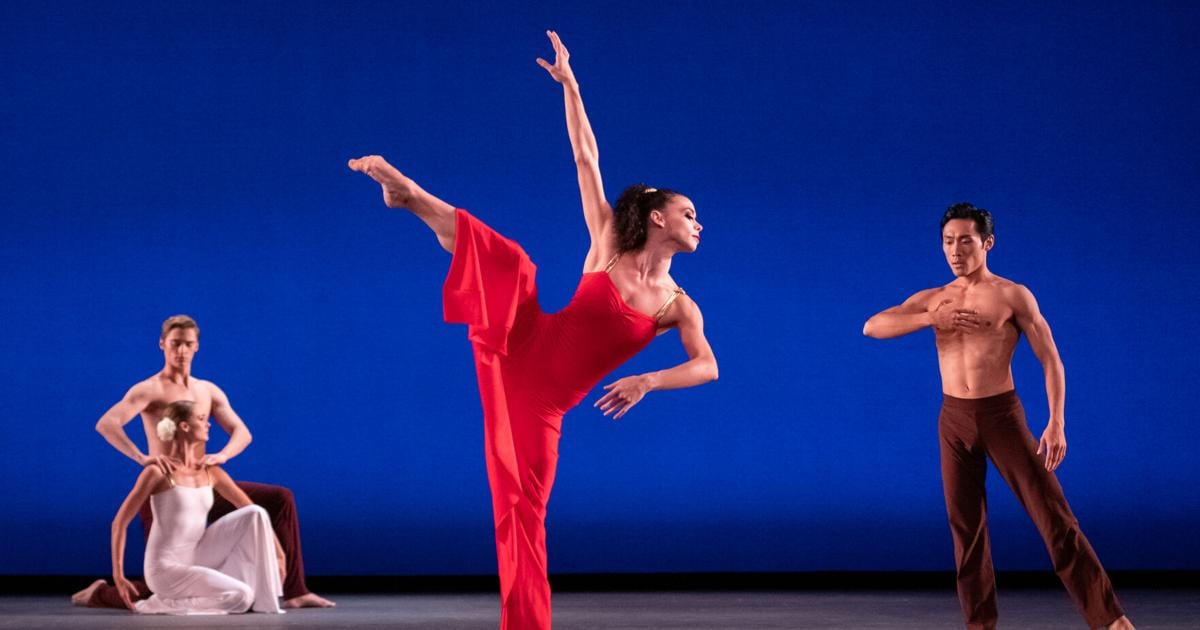DANCE REVIEW: Miami City Ballet closes out Jacob’s Pillow 90th anniversary season | Berkshirelandscapes

BECKET — The dancing in Wednesday’s opening night performance of Miami City Ballet, at Jacob’s Pillow Dance Festival, was almost universally sublime. Certainly, there were angels — in Martha Graham’s “Diversion of Angels” and in George Balanchine’s “Serenade” — and there were ghosts — in “Geta,” Margarita Armas’ homage to a beloved teacher who recently died, and in Jerome Robbins’ “Antique Epigraphs,” in which it seems that figures immortalized on Greek vases come to floating, fantastic life. The company also happened to bring along a small orchestra — breaking the seal, finally, on the new “pit” added during the Ted Shawn Theatre’s renovations — adding frosting to this angel-food cake.
Surely one sign of a dance company’s exceptionalism is when it performs, as this company does, “legacy” repertoire in a manner that make the works seem fresh. Aside from “Geta,” the youngest of the program’s other dances — Robbins’ 1984 “Antique Epigraphs” — is nearly 40 years old. Staged for the company by Christine Redpath, this enigmatic piece for eight women is subtly perfumed with a potpourri of accents (wit, eroticism, ritualism, mischievousness, even hints of danger). In Florence Klotz’s lovely, long, gauzy pastel tunics, the women alternate between a kind of staccato austerity — walking and pausing with parallel legs, arms etching purposely rigid positions — and bursts of buzzing activity, bursting into storms of châine turns or eddying in paddle turns or bustling about the stage in energetic prances. Pianists Ciro Foderé and Francisco Rennó, performing Debussy’s “Six épigraphes antiques” and flautist Linda Toote, performing Debussy’s “Syrinx,” accompany the dancers with an intimate intensity.
That musical sensitivity is present even when the pit swells with the orchestra performing Tchaikovsky’s Serenade for Strings, the score for Balanchine’s 1934 “Serenade,” the first ballet the St. Petersburg-born choreographer made upon arriving in the US. This week’s performances mark the first time this iconic jewel has been performed at the Pillow, thanks to another aspect of the Ted Shawn Theatre’s renovations, the expansion of the stage area. Even so, it’s a snug fit during the women’s large ensemble sections, as ingenious patterns and formations appear and dissolve, the dancers sweeping around the stage and one another with a beeline precision belied by the soft clouds of their long tulle skirts (designed by the incomparable Karinska) and the dancers’ seeming calm. This was a model of the famously daring, go-for-broke kind of dancing that Balanchine insisted upon.
The leads in Wednesday’s performance were likewise focused. Taylor Naturkas traversed the stage with darting clarity, like the eye of a storm. Tricia Albertson was stirring as the woman who waltzes, dreamily, with one man (Renan Cerdeiro) before being drawn into a feverish (but beautiful) nightmare of sorts, when Jordan-Elizabeth Long’s canny angel/devil character brings another man (Chase Swatosh) into the mix. Cerdeiro and Swatosh are both exceptional partners, and beautiful dancers themselves. Toward the end of the dance, Long and Swatosh tip briefly into melodrama, but otherwise, the performance of this (one of my desert-island ballets) was thrilling.
Cerdeiro’s passion, both physically and artistically, throughout “Serenade,” was striking, even in the big group movements, when one could, in such a crowd, get away with doing a bit less. He seemed to do increasingly more, as if drawn in to the drama of the movement, the music — reaching again and again into his glorious arabesque line, before sprinting offstage with burning passion. In “Geta,” Armas’ tribute to Geta Constantinescu set to Nina Simone’s deeply melancholic performance of Jacques Brel’s song “Ne Me Quitte Pas,” Cerdeiro avoids sentimentality, infusing the mixture of explosive jetés and anguished crouches with the same sincere depth.
That the dancers would excel in the Balanchine and Robbins works is not a surprise: Miami City Ballet is one of the small cohort of ballet companies with direct lineage to the Balanchine/Robbins mother ship, New York City Ballet. Founded by one former City Ballet star, Edward Villella, the company has been under the direction of another City Ballet principal dancer, Lourdes Lopez, for ten years now. (Congratulations, Ms. Lopez!) That the company also triumphed in Graham’s 1948 “Diversion of Angels” is a testament to the staging of Peggy Lyman Hayes and Peter Starling, and also to these dancers’ technical prowess, yes, but mostly to their deep-hearted devotion to their profession.
It takes years for a dancer to absorb the specificities of a particular style, and so it’s not an easy task for non-Graham-trained dancers, no matter how exceptional, to take on a deliriously difficult work such as “Angels.” The Miamians dive into this world of contractions and strikingly stylized physicality with seemingly fearless resolve, so that, again, the work itself is honored. The few wobbles — this may be Graham’s ode to various stages of love, but it’s not, technically-speaking, for the faint of heart — are easily forgiven in this otherwise powerful performance. As in “Serenade,” the leads — Dawn Atkins and Swatosh, the grounded, stately “Couple in White”; Katia Carranza and Steven Loch, the passionate “Couple in Red”; and Juliet Hay and Ariel Rose, the playfully youthful “Couple in Yellow” — are matched by the “Chorus.” Ellen Grocki, Petra Love, Nicole Stalker, Matilda Solis, and Julian Goodwin-Ferris (the latter is often joined by the three lead men, borrowed from their duet duties) enter and exit with stunning, continuous energy. This is how the program began, with a homerun; the hits just kept coming.DANCE REVIEWWho: Miami City Ballet
Where: Ted Shawn Theatre, Jacob’s Pillow, 358 George Carter Road, Becket
When: Through Aug. 28
Performances: 8 p.m., Aug. 26 and 27; 2 p.m., Aug. 27 and 28
Tickets: $65 — $85
Reservations and information: 413-243-9919, jacobspillow.org


